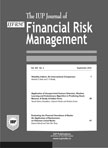|

Sep'16 |
Focus
The present issue comprises three research papers. The first paper, “Volatility
Indices: An International Comparison”, by Maithili S Naik and Y V Reddy,
examines the dynamic linkages among the leading global volatility indices such as US VIX, Germany VDAX, India VIX, South Korea VKOSPI...
|
|
|
Articles |
| |
Volatility Indices: An International Comparison
--Maithili S Naik and Y V Reddy
Volatility index is a measure of markets expectation of volatility over the near-term. It is a forward looking instrument and depicts the expected market volatility over the next 30 days. The constant ups and downs in the financial markets are a cause of concern for most investors. Thus, the volatility index helps them to keep track of market volatility and guide them in their investment decisions. The objective of this paper is to understand the dynamics of linkages between the volatility indices of US (VIX), Germany (VDAX), India (VIX), South Korea (VKOSPI) and China (VXFXI). The VAR model with impulse response function and variance decomposition analysis has been used to understand the linkage dynamics. The results suggest that the US VIX is the most influential index. Therefore, this index should be closely observed by overseas regulatory authorities as early warning signal for future turbulence in their domestic markets. The results for the Indian VIX reveal that there is a moderate level of influence of the US index on it. Further, the Indian VIX seems to be integrated minimally with its Asian equivalents
© 2016 IUP. All Rights Reserved.
Application of Unsupervised Feature Selection, Machine Learning
and Evolutionary Algorithm in Predicting Stock Returns:
A Study of Indian Firms
--Tamal Datta Chaudhuri, Indranil Ghosh and Shahira Eram
Prediction of stock prices has become an important area of research in the field of financial analytics and has garnered a lot of attention among academicians. Drawing on the literature on application of econometric tools and also machine learning techniques, this paper presents a framework for predicting stock returns using three unsupervised feature selection techniques, four predictive modeling techniques and finally an ensemble combining the four predictive modeling techniques. To design the ensemble, evolutionary algorithm is applied. In order to assess the results of our study, four different performance measures, namely, Mean Absolute Error (MAE), Mean Squared Error (MSE), Nash-Sutcliffe Efficiency (NSE) and Index of Agreement (IA) have been utilized. Our feature selection results indicate that all explanatory variables are not significant for different classes of companies and also for different time periods. This gives us insight into the fact that, for stock returns prediction, one has to be careful of the predictors to be chosen. Further, results indicate that for all the forecasting methods, namely, random forest, bagging, boosting and support vector regression, forecasting efficiency for large cap and mid-cap firms was better than that of small cap firms. Statistical analysis through Analysis of Variance (ANOVA) suggests that of all four predictive modeling techniques, boosting was the most efficient technique for forecasting the stock returns. We then proceeded to construct an ensemble of the above four methods. In terms of all four measurement metrics, performance of the proposed ensemble was better in both training and testing phase as compared to the efficiency of the individual predictive modeling techniques.
© 2016 IUP. All Rights Reserved.
Evaluating the Financial Soundness of Banks:
An Application of Bankometer on Pakistani Listed Banks
--Aasma Ashraf and Yasir Bin Tariq
Financial system of a country is an important system in its economy. The sustainability and growth of banking sector is critical for development of the financial sector as well as economic growth. Economic development of a country is reflected through the soundness of its banking system. Therefore in order to sustain and grow, banks have to be financially sound. Many researchers in Pakistan and in other countries have conducted studies on evaluating the financial soundness of banking sector by using different tools and methods. Bankometer is used in this study to evaluate the financial soundness of banks. It is a new and efficient model and computationally less expensive than other models like CAMELs and CLSA-stress test. To confirm its accuracy, it has been applied on each banks listed on Pakistan Stock Exchange over the period 2006-2014. Soundness of each bank has been computed separately which demonstrate which bank is super stable and which is close to insolvency. For comparison purpose, Z-score model is also used for banks listed on Pakistan Stock Exchange. These two models reported the same results, but however some are slightly different. As per the results of both models Bank of Punjab’s financial soundness is in grey area and need to be enhanced to reach in the protected zone with a score of soundness (70).
© 2016 IUP. All Rights Reserved.
|


